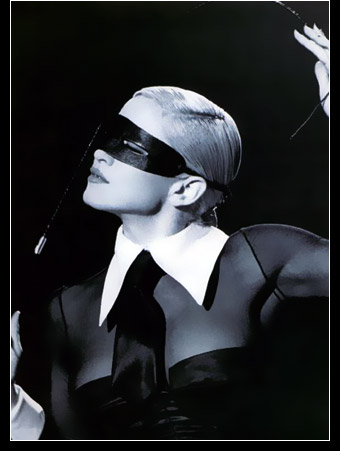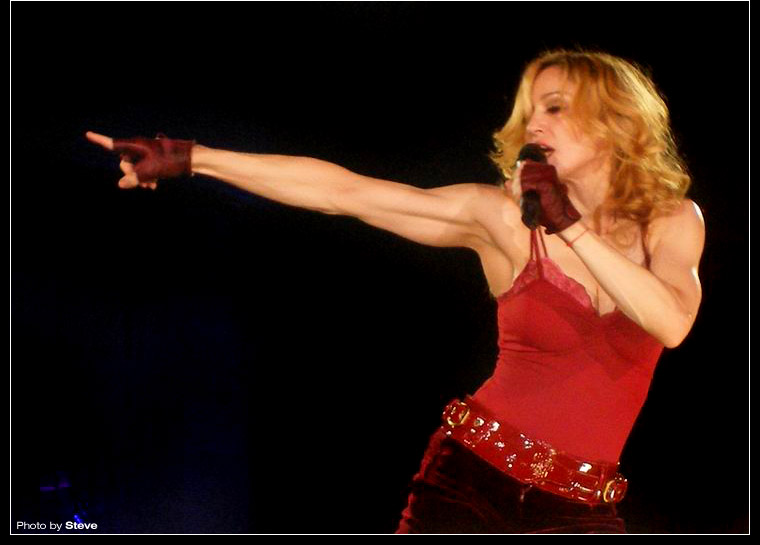| |
| |
 |
|
| |
|
|
| |
From the East Village street urchin to virgin bride, from peep show stripper to spiritual mother, from dominatrix to Hindu goddess, Madonna has personified all of these images and more. To the general public it appears as though Madonna - the person - takes on these images in a calculated attempt to maintain relevance in a fickle marketplace. Yet Madonna - the artist - has always considered herself a performance artist, a self-described appropriator of cultural references, highbrow art, and international religions. Her image is her art; she is the canvas onto which she paints a multimedia portrait
The general misconception of her is that her various images are simply marketing tactics to sell her lowbrow music. I personally don't think it is that simple. To believe this version of Madonna is to discredit her longevity and success across demographics and global cultures. According to the Guinness Book of World Records Madonna is the best selling female artist of all time with over 250 million records sold worldwide. And to those who have questioned her relevance in modern popular culture, they need only look at her latest entry in the Guinness Record Books: her 2006 Confessions World Tour was the highest grossing concert tour by a female artist of all time with almost $200 million in ticket sales. Could anyone achieve such success by simply being a clever businesswoman and marketer?
Certainly her art has connected with the public in a profound way
Another misconception is that her success is driven by sex and controversy. Without question, these elements are part of her formula, but again, the secret to her success is much more complicated than simply scandal. On the other hand, it would be inaccurate to attribute her success and longevity to her music alone
While she has certainly made an indelible mark in contemporary American popular music, her primary talent is not that of a singer or composer, but instead of conductor of an all-encompassing orchestra that includes the visual, the audible, and the sensorial. |
|
| |
She immerses herself completely in a concept, from image to sound, from persona to performance. What the audience sees is the character in Madonna's latest production. It is this kaleidoscope of images and personae (different from the person) that keeps her interesting to the public. The audience never sees the woman behind the mask so they never get bored. All we know of Madonna is that she is an imposing person with control over her product and with feminist inclinations. We know only what Madonna wants to reveal of herself, which begs the question: What is behind the mask? The answer is most likely a narcissist.
Christopher Lasch's definition of narcissism is strikingly fitting to what we know of the woman behind the mask. "The new narcissist is haunted not by guilt but by anxiety. He seeks not to inflict his own certainties on others but to find a meaning in life. Liberated from the superstitions of the past, he doubts even the reality of his own existence. Superficially relaxed and tolerant, he finds little use for dogmas of racial and ethnic purity but at the same time forfeits the security of group loyalties and regards everyone as a rival for the favors conferred by a paternalistic state. His sexual attitudes are permissive rather than puritanical, even though his emancipation from ancient taboos brings him no sexual peace. Fiercely competitive in his demand for approval and acclaim, he distrusts competition because he associates it unconsciously with an unbridled urge to destroy. Hence he repudiates the competitive ideologies that flourished at an earlier stage of capitalist development and distrusts even their limited expression in sports and games. He extols cooperation and teamwork while harboring deeply antisocial impulses. He praises respect for rules and regulations in the secret belief that they do not apply to himself.
|
|
 |
Acquisitive in the sense that his cravings have no limits, he does not accumulate goods and provisions against the future, in the manner of the acquisitive individualist of nineteenth-century political economy, but demands immediate gratification and lives in a state of restless, perpetually unsatisfied desire."
Madonna could be considered Lasch's prime example of narcissism: fiercely competitive, seeking meaning in life through her art by appropriating dogmas, and just as quickly discarding them, sexual permissiveness which has been interpreted by some as female sexual liberation. It would seem that her art is driven by her narcissism. Yet it is interesting that her narcissism drives her to put on masks rather than exposing more of herself to the public.
Madonna is seemingly empowered by her liberated points of view toward sex and gender. Most of her art takes on a feminist approach to women's sexual liberation as in her Sex book, which sought to level the playing field of sexual fantasy and exploitation between men and women. It was her overwhelmingly direct affront on American mores that created the 1992 backlash against her. Lasch said that “Whereas the resentment of women against men for the most part has solid roots in the discrimination and sexual danger to which women are constantly exposed, the resentment of men against women, when men still control most of the power and wealth in society yet feel themselves threatened on every hand - intimidated, emasculated - appears deeply irrational, and for that reason not likely to be appeased by changes in feminist tactics designed to reassure men that liberated women threaten no one... there is not much that feminists can say to soften the sex war or to assure their adversaries that men and women will live happily together when it is over.” Not only did Madonna challenge the ideology of sexual women, she defied the unwritten rules of celebrity when she exposed herself to the media instead of being exposed by the media.
|
|
| |
Her exposure, however shocking, was superficial in its contrivance. In Sex, Madonna took on the character and persona of Dita Parlo, a 1930's silent film actress. Through Dita, Madonna played out sexual fantasies in her writing and in still photography. Had she exposed herself in a moment of vulnerability and true sexual climax, she might have exposed something of the person behind the character, but the viewer is never given more than the tease of gratification, leaving them wanting - and wondering - more. Today's Madonna is more age-appropriate as she explores highbrow themes of religious imagery, social causes such as poverty and adoption, and children's books.
Lasch says that 'our society notoriously finds little use of the elderly. It defines them as useless, forces them to retire before they have exhausted their capacity for work, and reinforces their sense of superfluity at every opportunity." It will be interesting to follow the next act of Madonna's performance if only to see what characters she will take on in her attempt to defy the inevitable obstacle of age.
|
|
 |
| |
|
|
| |
Works Cited
Fouz-Hernández, Santiago and Freya Jarman-Ivens. Madonna's Drowned Worlds: New Approaches to her Cultural Transformations, 1983-2003. Vermont: Ashgate, 2004.
Guilbert, Georges-Claude. Madonna as Postmodern Myth: How One Star's Self- Construction Rewrites Sex, Gender, Hollywood, and the American Dream. North Carolina: McFarland & Co., 2002.
Lasch, Christopher. The Culture of Narcissism: American Life in An Age of Diminishing Expectations. New York: Norton & Company, 1979.
|
|
| |
All images are property of the copyright owner. This article ©
2007 MadonnaTribe - All rights reserved.
|
|
 Your favourite stop for latest Madonna
news, previews, articles, exclusive interviews, magazine and
cover scans,
Your favourite stop for latest Madonna
news, previews, articles, exclusive interviews, magazine and
cover scans,
picture galleries, and Community Forum. This site is not endorsed
by Madonna or Warner Bros Records.
From fans to fans, © 2003-2007 Madonna Tribe
|
|
 |
|
|
